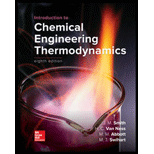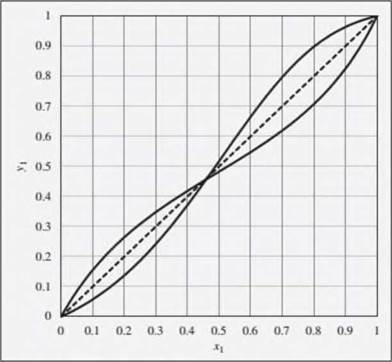
Problems 12.29 through 12.33 refer to the xy diagram provided in Fig. 12.23. This diagram shows xy curves both for ethanol(1)/ethyl acetate(2) and for chloroform(1)/tetrahydrofuran(2), both at a constant pressure of 1 bar. The curves are intentionally unlabeled. Readers should refer to Figs. 12.19 through 12.22 to deduce which curve is for which pair of substances.

Figure 12.23: xy dia¬gram for ethanol(1)/ethy1 acetate( 2) and for chloro-form(1)/lctrahydrofuran(2), both at a constant pressure of 1 bar. Note that the curves arc intentionally unlabeled, but they can be identified based on infor-mation presented in Figs. 12.19 through 12.22.
12.33. Consider a binary liquid mixture for which the excess Gibbs energy is given by . What is the minimum value of A for which liquid/liquid equilibrium is possible?
Trending nowThis is a popular solution!

Chapter 12 Solutions
Loose Leaf For Introduction To Chemical Engineering Thermodynamics
- Derive the formula boundary-s layer, thickness 5x Rexarrow_forwardQ2] The reaction AR + S is irreversible and first order. It is conducted in a PFR with 50 tubes, each with 0.5 in diameter and 1.0 m of height. 200 kg/h of reactant A (MW-80 g/gmol) with 30% inert is introduced at a pressure of 50 atm at 500°C. The output conversion is 80%. Calculate the average residence time.arrow_forwardplease, provide me with right resultsarrow_forward
- Ex. HW. A vertical glass tube, 2cm ID & 5m long in heated uniformly over its length. The water enter at (200-204 C) & 68.9 bar calculated the pressure drop if the flowrate 0.15 Kg/s & the power applied as a heat to the fluid is 100KW using the homogeneous model. Given that enthalpy at inlet temp.=0.87MJ/Kg, enthalpy saturation temp (285C)=1.26 MJ/Kg and μl=0.972*10-4 Ns/m2, μG=2.89*10-5 Ns/m2, UG=2.515*10-2m3/Kg and the change in UG over range of pressure=-4.45*10-4m3/Kg/bar.arrow_forward4. An experimental test rig is used to examine two-phase flow regimes in horizontal pipelines. A particular experiment involved uses air and water at a temperature of 25°C, which flow through a horizontal glass tube with an internal diameter of 25.4 mm and a length of 40 m. Water is admitted at a controlled rate of 0.026 kgs at one end and air at a rate of 5 x 104 kgs in the same direction. The density of water is 1000 kgm³, and the density of air is 1.2 kgm. Determine the mass flow rate, the mean density, gas void fraction, and the superficial velocities of the air and water. Answer: 0.02605 kgs 1, 61.1 kgm³, 0.94, 0.822 ms-1, 0.051 ms-1arrow_forwardand the viscosity of the water is 1.24 × 104 Nsm 2. Answer: Slug flow 1. Determine the range of mean density of a mixture of air in a 50:50 oil-water liquid phase across a range of gas void fractions. The den- sity of oil is 900 kgm³, water is 1000 kgm³, and gas is 10 kgm³.arrow_forward
- A chemical reaction takes place in a container of cross-sectional area 50.0 cm2. As a result of the reaction, a piston is pushed out through 15 cm against an external pressure of 121 kPa. Calculate the work done (in J) by the system.arrow_forwardExample 7.2 Steam is generated in a high pressure boiler containing tubes 2.5 m long and 12.5 mm internal diameter. The wall roughness is 0.005 mm. Water enters the tubes at a pressure of 55.05 bar and a temperature of 270°C, and the water flow rate through each tube is 500 kg/h. Each tube is heated uniformly at a rate of 50 kW. Calle (a) Estimate the pressure drop across each tube (neglecting end effects) using (i) the homogeneous flow model and (ii) the Martinelli-Nelson correlation. (b) How should the calculation be modified if the inlet temperature were 230°C at the same pressure?arrow_forwardPlease solve this question by simulation in aspen hysysarrow_forward
- (11.35. For a binary gas mixture described by Eqs. (3.37) and (11.58), prove that: 4812 Pу132 ✓ GE = 812 Py1 y2. ✓ SE dT HE-12 T L = = (812 - 7 1/8/123) d² 812 Pylyz C=-T Pylyz dT dT² See also Eq. (11.84), and note that 812 = 2B12 B11 - B22. perimental values of HE for binary liquid mixtures ofarrow_forwardplease provide me the solution with more details. because the previous solution is not cleararrow_forwardplease, provide me the solution with details.arrow_forward
 Introduction to Chemical Engineering Thermodynami...Chemical EngineeringISBN:9781259696527Author:J.M. Smith Termodinamica en ingenieria quimica, Hendrick C Van Ness, Michael Abbott, Mark SwihartPublisher:McGraw-Hill Education
Introduction to Chemical Engineering Thermodynami...Chemical EngineeringISBN:9781259696527Author:J.M. Smith Termodinamica en ingenieria quimica, Hendrick C Van Ness, Michael Abbott, Mark SwihartPublisher:McGraw-Hill Education Elementary Principles of Chemical Processes, Bind...Chemical EngineeringISBN:9781118431221Author:Richard M. Felder, Ronald W. Rousseau, Lisa G. BullardPublisher:WILEY
Elementary Principles of Chemical Processes, Bind...Chemical EngineeringISBN:9781118431221Author:Richard M. Felder, Ronald W. Rousseau, Lisa G. BullardPublisher:WILEY Elements of Chemical Reaction Engineering (5th Ed...Chemical EngineeringISBN:9780133887518Author:H. Scott FoglerPublisher:Prentice Hall
Elements of Chemical Reaction Engineering (5th Ed...Chemical EngineeringISBN:9780133887518Author:H. Scott FoglerPublisher:Prentice Hall
 Industrial Plastics: Theory and ApplicationsChemical EngineeringISBN:9781285061238Author:Lokensgard, ErikPublisher:Delmar Cengage Learning
Industrial Plastics: Theory and ApplicationsChemical EngineeringISBN:9781285061238Author:Lokensgard, ErikPublisher:Delmar Cengage Learning Unit Operations of Chemical EngineeringChemical EngineeringISBN:9780072848236Author:Warren McCabe, Julian C. Smith, Peter HarriottPublisher:McGraw-Hill Companies, The
Unit Operations of Chemical EngineeringChemical EngineeringISBN:9780072848236Author:Warren McCabe, Julian C. Smith, Peter HarriottPublisher:McGraw-Hill Companies, The















